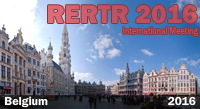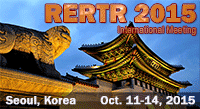IAEA/USA Interregional course on
Preparations to Ship Spent Nuclear Fuel (1997)
OVERVIEW OF LOCAL
ARRANGEMENTS IN JAPAN
![]() PDF version available
PDF version available
DOWNLOAD full paper in PDF format.
Contact:
Mr. Fusao Nakayama
Department of JMTR
JAERI Oarai Research Establishment
Oarai-machi, Ibaraki-ken 311-13
Japan
Tel.: +81-29-264-8311
Fax: +81-29-264-8480
E-mail: nakayama@jmtr.oarai.jaeri.go.jp
IAEA/USA Interregional Training Course
Technical and Administrative Preparations Required for Shipment of Research Reactor Spent
Fuel to its Country of Origin
13-24 January 1997
Argonne, IL
OVERVIEW OF LOCAL
ARRANGEMENTS IN JAPAN
L.5.2
F. NAKAYAMA
JAPAN ATOMIC ENERGY RESEARCH INSTITUTE
SUMMARY
For the shipment of spent fuel, it is necessary to prepare transporting cask
and to deal with many arrangements. In order to design and manufacture the casks,
some legal approvals must be taken. In the experience of the design and manufacture
taken the newest casks which would be used for the transport of spent fuel of
research reactors at the Japan Atomic Energy Research Institute(JAERI), it took
about three and half years from start of design until the cask approval was
obtained. For every shipment, there are many arrangements such as application
of permission and confirmation, notification, declaration etc. . In order to
deal with these arrangements, it takes about a half year.
L.5.2 OVERVIEW OF LOCAL ARRANGEMENTS IN JAPAN
FOREWORD
For the shipment of spent fuel, it is necessary to prepare transporting cask
and to deal with many arrangements. Spent fuel of research reactors in the Japan
Atomic Energy Research Institute (JAERI) had been returned to the USA or transported
to overseas reprocessing plants except some reactors. The shipments had been
carried out since 1966 and have suspended since 1989. Total number of transported
spent fuel elements reached 2,284, and total number of shipments were 37 times.
The casks used for these shipments were: (1) bought used one from the USA, (2)
manufactured by a company in the USA, (3) Leased from England, and (4) manufactured
by a Japanese company. The details of these casks were described in "L.13.4
JAPANESE EXPERIENCE WITH SHIPMENT OF RESEARCH REACTOR SPENT FUEL " .
Until the early 1970's, these alternatives were easily taken because relevant
regulations were not so strict. However, as the regulations became more strict,
to take license became more difficult. For the future shipments of spent fuel
of JAERI, casks described in above (4) will be only used.
There are many arrangements to be dealt with for the shipments. If arrangements
to be taken for the shipments of spent fuel of Japan Materials Testing Reactor
(JMTR) at JAERI are roughly classified, they are :(1) application for permission,
confirmations etc. ; about 20 items, (2) notification, declaration etc. ; about
20 items, (3) competent authorities, local governments etc. needed explanation
; about 15 offices, (4) inspections by competent authorities ; 5 items, and
(5) contracts ; 6 items. In order to deal with these arrangements, it will take
about a half year for a regular shipment. However, for the shipment after long
blank such as a shipment scheduled in 1997, which have almost 10 years blank,
it will need to start much earlier.
1. LAWS FOR TRANSPORT OF SPENT FUEL IN JAPAN
There are two laws for control radioactive material in Japan. One is "
The Law for Regulations on Nuclear Source Material, Nuclear Fuel Material and
Reactors" (it is called " The Reactor Regulation etc. Law"),
and the other is "The Low concerning Prevention from Radiation Hazards
due to Radio-Isotopes etc. " (it is called " The Radiation Hazards
Prevention Law " ). Transport of nuclear fuel material and radio-isotopes
are prescribed by the " The Reactor Regulation etc. Law" and "
The Radiation Hazards Prevention Law " respectively. They are based on
the "IAEA Regulations for the Safe Transport of Radio Active Material"
. The competent authorities for regulating nuclear fuel transport are shown
in Figure-1.
2. EXPERIENCE OF DESIGN AND MANUFACTURE OF TRANSPORTING CASK
The newest type of spent fuel transporting cask in JAERI is the cask for the JMTR spent fuel. The cask name is JMS-87Y-18.5T. The experiences of design, fabrication and licensing are introduced in this section.
The entire cask is made of stainless steel attached shock absorbers to the top and bottom of the cask. These shock absorbers are made of plywood covered with stainless steel plates. The cask can accommodate 30 spent fuel elements, and its weight is 18.2tons. The conceptional drawing of the cask is shown in Figure-2, and the JMTR spent fuel elements to be contained in the cask are also shown in Figure-2. In order to reduce the size, the top section and bottom adapter are cut prior to loading into the cask.
It took 22 months for cask design, fabrication of a full scale model of the cask, tests conducted on the model cask and application for safety review on the cask design by the Japanese Safety Committee. And it took about 20 months for the safety review, obtaining approval for cask design, fabrication, inspections by competent authority and obtaining cask approval. Accordingly, almost three and a half years were spent from start of design until cask approval was taken. In addition to the design approval of Japan, approvals by six supposed countries through or into which cask would be to be transported were obtained. Design and fabrication procedures of the cask are shown in Figure-3, and the test flow conducted on the model cask is shown in Figure-4.
Design approval of cask must be revised every three years in Japan. In order to verify integrity of the casks, the casks must be inspected by the owner once a year. The inspection results must be submitted to the competent authority with application for getting the revised design approval. The inspection results are reviewed by inspectors of the competent authority, then the revised design approval is issued to the owner. It takes about three months from application to issue.
3. ARRANGEMENTS FOR TRANSPORT IN JAPAN
Major items of arrangements for transport of the JMTR spent fuel are listed
in the following tables respectively.
| Applications for permission, confirmations etc. | : in Table-l |
| Submission, notifications, declarations etc. | : in Table-2 |
| Competent authorities, local governments etc. needed explanation |
: in Table-3 |
| Inspections by competent authorities | : in Table-4 |
| Contracts | : in Table-5 |
Because there are so many arrangements as shown in these tables, it is impossible
to deal with all duties by a few members of a fuel management group at JMTR.
So, clerks in administrative divisions of the Oarai Research Establishment support
them. Members to promote the arrangements are 3 or 4 of the fuel management
group and almost same members of the administrative divisions.
4. THE SITUATION OF THE SPENT FUEL TRANSPORT IN JAPAN
The ground transport of the JMTR spent fuel has the longest distance in the research reactors at JAERI. The reason is described in "L.13.4 JAPANESE EXPERIENCE WITH SHIPMENT OF RESEARCH REACTOR SPENT FUEL". The actual state of ground transport of the JMTR spent fuel is introduced in this section.
A head office of the spent fuel transport is set up at the Oarai Research Establishment during ground transport. The transport is carried out at midnight because of avoiding traffic jam. In order to keep safety transport and to cope effectively with matter what happens, following JAERI members accompany, and employees of a transport company and a security company attend the transport.
- One person responsible of the transport
- One expert of radiation control
- One expert having national qualification of the supervisor of nuclear fuel
- More than ten staff members including professional radiation control members (most of them have national qualification of the supervisor of nuclear fuel and/or of the supervisor of radiation control)
- About 15 employees of the transport company
- About 15 guardsmen of the security company
Furthermore, several police cars escort and guard the transporting file.
Of course, these organizations, personnel organizations and an arrangement of
the transport file are submitted to competent authorities and local governments.
If any comments are given by them, JAERI conducts further examination. Finally,
they are notified to the competent authorities and local governments.
Since the speed of the load vehicle was restricted to 30km/h, the file covered
about 30km from JMTR to the port in almost two hours. The situation of the transport
and the time passing check points are informed to the head office by radio of
a car of the security company. If something happened, it is informed to the
competent authorities and local governments from the head office at once. After
the file arrived to the port, they wait until loading which begins at the sunrise.
AFTERWORD
The arrangements for the spent fuel transport are troublesome tasks. In order
to avoid something trouble on the transport, the competent authorities and local
governments impose conditions on the transport. The arrangements are being proceeded
while solving such subjects. By our experience, it took about four or five months
from shipment to return of the empty cask to JMTR. Accordingly, the maximum
frequency of the shipment would be twice a year.
Table-l Applications for Permission, Confirmation etc.
| Confirmation of Nuclear Material Package to be transported | STA |
| Inspection prior to Shipment of Package | STA |
| Passage Permission of Special Load Vehicle | MOC One Prefecture One City One Village |
| Approval of Loading Method | MOT |
| Confirmation of Safe Transport Plan of Radioactive Material | MOT |
| Special Exception of Load Limit | MOT |
| Loading Inspect ion of Dangerous Cargo | MOT |
| Confirmation of Transport Agreement | STA |
| Permission of Load Service | MITI |
| Export Approval | MITI |
| Traffic Permission out of Designated Region | Custom |
| Permission of Storage at Place out of Designated Region | Custom |
| Permission of Load/Unload out of Duty Time | Custom |
STA : the Science and Technology Agency
MOC: the Ministry of Construct ion
MOT: the Ministry of Transport
MITI :the Ministry of International Trade and Industry
Table-2 Submission, Notification, Declaration, etc.
| Submission of Design Evaluation of Tie-down | MOT |
| Submission of Design Analysis of Tie-down | MOT |
| Notification of Reports on Transport of Nuclear Material | Public Safety Commission of one Prefecture |
| Submission of Reports on Transport of Radioactive Material | MSA |
| Request for Security Guard for Transport | MSA |
| Submission of Appendix-A and Appendix-B | US. DOE |
| Request for Use of Port | JAPCO |
| Request for Use of Equipment at Port | JAPCO |
| Submission of Results of Loading Inspection on Ship | JAPCO, Port Service Company |
| Submission of Reports on Plan of Receipt / Shipment of Nuclear Material | STA |
| Submission of Reports on Plan of Nuclear Material Export | STA |
| Export Declaration of Fuel | Custom |
| Export Declaration of Cask | Custom |
| Notification of Cargo Operation | Custom |
| Submission of Consignor's Certification of SF shipment | Captain |
JAPCO : Japan Atomic Power Company
MSA : the Maritime Safety Agency
Table-3 Competent Authorities, local governments etc. needed to explain
| STA | Nuclear Fuel Control Division Nuclear Reactor Control Division Policy Division Nuclear Fuel Division Research and Technology Division Atomic Office in the Prefecture |
| MOJ | Immigration Office |
| Local Government | One Prefecture Two Cities, one Town and one Village |
| Police | Prefecture Police Head Station Four Local Police Stations |
| Fire Station | Prefecture Fire Head Station Five Local Fire Stations |
| Overseas Reprocessing Committee | |
| Prefecture Fishermen's Union |
MOJ: the Ministry of Justice
Table-4 Inspections by Competent Authorities
| Inspection prior to shipment | STA |
| Loading inspection on vehicle | MOT |
| Loading inspection on ship | MOT |
| Loading confirmation and Sealing of cask | IAEA, STA |
| Proof test of Lifting tools | Japan Maritime Association |
Table-5 Contracts
| Reprocessing | US. DOE |
| Marine Transport | BNFL |
| Ground Transport and Loading in Japan (Includes Security Service for Ground Transport in Japan ) |
Transport Company |
| Liability Insurance for Nuclear Damage | Japan Atomic Energy Insurance Pool |
| Indemnity Agreement for Compensation of Nuclear Damage |
STA |
| Service Agreement | Trading Company |
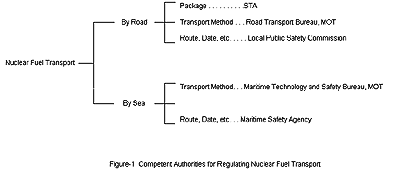
Figure 1.(![]() See
full-size image)
See
full-size image)
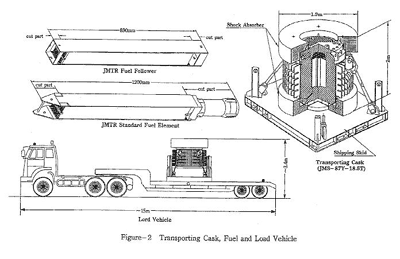
Figure 2.
(![]() See
full-size image)
See
full-size image)
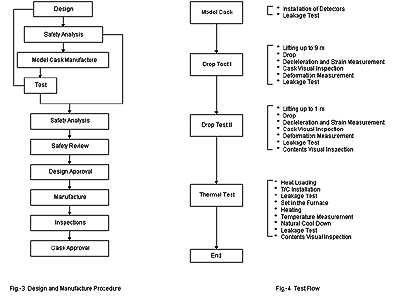
Figure 3.
(![]() See
full-size image)
See
full-size image)



